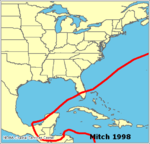Hurricane Mitch
From Wikipedia, the free encyclopedia.
|
Hurricane Mitch at peak intensity |
|
| Duration | Oct. 22 – Nov. 5, 1998 |
| Highest winds | 180 mph (290 km/h) sustained |
| Damages | $6–7 billion (2005 dollars) |
| Fatalities | 9,086–18,000 direct (deadliest Atlantic hurricane since the Great Hurricane of 1780) |
| Areas affected | Honduras, Nicaragua, El Salvador, Guatemala, Yucatan Peninsula, south Florida |
| Part of the 1998 Atlantic hurricane season | |
Hurricane Mitch was one of the most powerful tropical cyclones ever observed, with maximum sustained winds of 180 mph (290 km/h). Mitch battered Central America from October 22 to November 5, 1998. It was the the second deadliest Atlantic hurricane in history, killing as many as 18,000 people. It also caused billions of US dollars in damages.
Storm history
Hurricane Mitch began life as an African tropical wave that entered the Atlantic on October 10. After moving across the Atlantic and into the Caribbean Sea, the wave began organizing in the southern Caribbean north of Colombia. It was classified as a tropical depression on October 22 while about 415 miles (670 km) south of Kingston, Jamaica. The depression moved westward slowly, and strengthened into Tropical Storm Mitch later that day.
Mitch, still moving slowly, reached hurricane strength on the 24th while 295 miles (475 km) south-southwest of Kingston. Mitch began intensifying rapidly and on October 26 was a Category 5 hurricane. Prior to its wind speed peak, Mitch's central pressure dropped to 905 mbar (hPa), one of the lowest pressures ever recorded in an Atlantic hurricane (see table below).
The eye of the storm traveled nearly parallel to the coast of Nicaragua and Honduras. Mitch passed over the Swan Islands on October 27, and weakened slightly as it approached Honduras. As it neared the coast, its forward motion stopped, and Mitch meandered off the northern coast of Honduras until the 29th. Mitch made landfall that day 70 n mi east of la Ceiba as a Category 2 hurricane. Now over land, Mitch continued to weaken, and was classified a tropical depression as it entered Guatemala on the 31st.
The depression dissipated, but a remnant circulation remained. On November 2, this system reorganized over the Bay of Campeche and Mitch again became a named storm while 150 miles (240 km) southwest of Mérida, Yucatán. Tropical Storm Mitch moved over Yucatán, and then across the southeastern Gulf of Mexico. Its final landfall was near Naples, Florida as a moderately strong tropical storm on November 5. Mitch became extratropical, and accelerated into the north Atlantic. It was tracked north of Great Britain on November 9.
| Ten most intense Atlantic hurricanes Intensity is measured solely by central pressure |
|||
|---|---|---|---|
| Rank | Hurricane | Year | Minimum pressure |
| 1 | Wilma | 2005 | 882 mbar (hPa) |
| 2 | Gilbert | 1988 | 888 mbar (hPa) |
| 3 | Labor Day | 1935 | 892 mbar (hPa) |
| 4 | Rita | 2005 | 897 mbar (hPa) |
| 5 | Allen | 1980 | 899 mbar (hPa) |
| 6 | Katrina | 2005 | 902 mbar (hPa) |
| 7 | Camille | 1969 | 905 mbar (hPa) |
| 8 | Mitch | 1998 | 905 mbar (hPa) |
| 9 | Ivan | 2004 | 910 mbar (hPa) |
| 10 | Janet | 1955 | 914 mbar (hPa) |
| Source: The Weather Channel | |||
Impact
Hurricane Mitch was the deadliest Atlantic hurricane since the Great Hurricane of 1780, displacing the Galveston Hurricane of 1900 as the second-deadliest on record. Eleven thousand people were confirmed dead, and just as many reported missing. Deaths were mostly from flooding and mudslides, when the slow-moving hurricane and then tropical storm dropped nearly 3 feet (900 mm) of rain. Mitch was the second deadly hurricane to hit Honduras since the beginning of modern tropical cyclone observation and forecasting. Hurricane Fifi in 1974 killed an estimated 8,000.
Tens of thousands of homes were damaged or destroyed, again mostly through flooding and mudslides. Precise damage estimates are not available, but are reported to exceed 5 billion (1998 USD). The bulk of the damage was in Honduras and neighboring Nicaragua, but El Salvador and Guatemala also received significant damage. Mitch was also responsible for the loss of the Fantome Windjammer sailing ship and all 31 crew on October 27 as recorded in the book "The Ship and The Storm" by Jim Carrier (ISBN 007135526X).
The name Mitch was retired in the spring of 1999 and was replaced with Matthew in the 2004 season.



